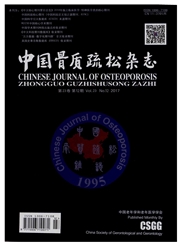

 中文摘要:
中文摘要:
目的了解福州地区绝经后妇女维生素D受体基因Apa Ⅰ多态性的分布,探讨维生素D受体基因ApaI多态性与绝经后妇女骨密度的关系。方法用双能x线骨密度仪检测592例绝经后妇女的L2-4、股骨颈,大转子和Ward三角区骨密度,应用PCR—RFLP技术检测维生素D受体基因ApaⅠ多态性。结果①维生素D受体基因型分布频率为AA型10.1%,aa型46.6%,Aa型43.2%。等位基因频率为A31.8%,a68.2%,基因型分布符合Hardy-Weinberg定律。②骨质疏松组与对照组基因型及等位基因分布频率差异均无显著性。③分析其基因型与骨密度的关系:AA、aa、Aa3种基因型在腰椎、股骨颈、大转子、Ward区4个部位骨密度均无显著性差异。结论维生索D受体基因Apa Ⅰ多态性与骨密度间无关联,不能作为预测福州地区绝经后妇女发生骨质疏松危险性的遗传标志。
 英文摘要:
英文摘要:
Objective To investigate the distribution of ApaI polymorphism of vitamin D receptor (VDR) gene in Fuzhou postmenopausal women and to explore the relationship between ApaI polymorphism of VDR gene and bone mineral density (BMD) in postmenopausal women. Methods BMDs of the lumbar vertebral L2-4 the femoral neck, the trochanter, and Ward's triangle area in 592 postmenopausal women were measured using dual energy X-ray absorptiometry. The ApaI polymorphism of VDR gene was determined by polymerase chain reaction-restriction fragment length polymorphism (PCR-RFLP). Results 1 ) The distribution frequencies of VDR genotypes AA, aa, and Aa were 10.1%, 46.6%, and 43.2%, respectively. The frequencies of allelic gene A and a were 31.8% and 68.2%. The distribution of VDR genotype followed the Hardy-Weinberg equilibrium. 2) There is no significant difference of genotype or frequencies of allele distribution between osteoporosis group and control group. 3 ) The analysis of the relationship between the VDR genotypes and BMD showed no significant difference between the genotypes AA, aa, or Aa and BMDs of the lumbar spine, the femoral neck, the trochanter and Ward's triangle. Conclusion ApaI gene polymorphism of VDR is not correlated with BMD and could not be considered to be a genetic marker to predict the risk of developing osteoporosis in postmenopausal females in Fuzhou.
 同期刊论文项目
同期刊论文项目
 同项目期刊论文
同项目期刊论文
 期刊信息
期刊信息
